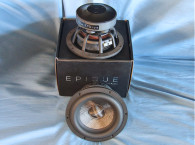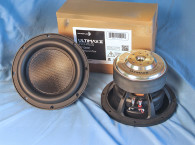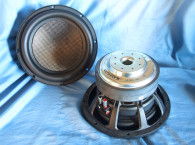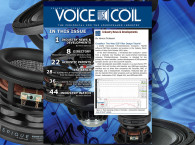
MMAG was invented by Enrique Stiles, and the MMAG patent (there are several) that applies to the E150HE-44, US6,917,690, was assigned to Step Technologies, Inc. Step Technologies was originally a partnership between two of the best transducer engineers with whom I have had the distinct pleasure of working—Enrique Stiles and Patrick Turnmire (Patrick has done much of the Klippel LSI analysis that has appeared in this column).
In practice, this dynamic duo had Enrique doing a lot of the conceptualization and Patrick heavy into application. This partnership also included Richard Calderwood, a world-class patent attorney, who is currently the Director of Intellectual Property at Nvidia, and was the former senior intellectual property attorney for Intel Corp. Together this talented trio fielded more than 40 transducer patents, which is quite impressive. While the partnership is no longer together, Enrique is still developing MMAG woofers, the latest example being this month’s first driver to be examined the Dayton Audio Epique E150HE-44. Enrique is now an independent transducer engineering consultant and developed the two new Epique full-range subwoofers in conjunction with the engineering team at Dayton Audio.
The Dayton Epique E150HE-44 is promoted as a full-range subwoofer, which in itself is an interesting concept, and one that is ideally suited to the MMAG technology given the typical high-excursion/low inductance aspect of this motor design. The EP150HE has a substantial feature set that begins with a proprietary six-spoke cast-aluminum frame, composed of narrow (about 9mm) spokes, completely open below the spider (damper) mounting shelf for cooling (Photo 1 and Photo 2).

Additional cooling for this driver is provided by six 4mm diameter vents in the voice coil former, as well as three 8mm diameter vents in the back plate. Additional cooling occurs as a result of the MMAG multi-magnet configuration. The primary magnetic drive is provided by the 121mm×25mm ferrite rear ring magnet, directly providing flux to the second rear 7mm gap. However, the secondary magnet system is comprised of six 28mm×8mm ferrite disks. These magnets do not add flux to the upper 7mm gap, but rather act as magnetic “diodes” (aka gap balancing magnets) pulling the flux from the main magnet into the top 7mm gap. These disks also provide an 8mm space between the two 7mm gaps as well as a conventional cooling path for the voice coil as it travels between the two gaps.
The cone assembly consists of an extremely stiff curvilinear-shaped carbon fiber cone fitted with a 1.6” diameter carbon fiber dust cap. Compliance is provided by 21mm wide NBR surround that has a mostly shallow transition to the cone attachment, with the remaining compliance coming from a 4” diameter flat cloth spider (damper).
The motor is an FEA-optimized dual-ferrite magnet type with milled plates and extended copper sleeve shorting ring (Faraday Shields) on the pole piece. Driving the cone assembly is a 38mm (1.5”) diameter dual voice coil (two 4Ω coils) wound with round copper-clad aluminum wire (CCAW) on an aluminum former. Last, RMS power handling is rated at 200W and the voice coil tinsel lead wires are stitched into the spider. The leads are then terminated to gold-plated solderable terminals located on opposite sides of the former to discourage rocking modes.
I began testing the Dayton E150HE-44 full-range subwoofer using the LinearX LMS analyzer and the Physical LAB IMP Box to create both voltage and admittance (current) curves. The driver was mounted to a rigid test fixture in free-air at 0.3V, 1V, 3V, 6V, 10V, 15V, 20V, and 30V with the oscillator on time between sweeps to simulate the actual thermal process over time. The 30V curves were too nonlinear to get a sufficient curve fit and were discarded. However, having a 5.5” driver testing out to 20V is spectacular as most 5” drivers don’t make it past 10V.
Following my established protocol, I no longer use a single added mass measurement and instead use the physically measured Mmd data (26 grams for the E150HE-44). The collected data, in this case the 14 550-point (0.3V to 20V) sine wave sweeps for each Epique sample were post-processed and the voltage curves divided by the current curves to generate impedance curves, with the phase derived using the LMS calculation method. I imported the data, along with the accompanying voltage curves, to the LEAP 5 Enclosure Shop software. Figure 1 shows the 1V free-air impedance curve. I selected the 1V TSL data in the transducer parameter derivation menu in LEAP 5 and created the parameters for the computer box simulations. Table 1 compares the LEAP 5 LTD/TSL Thiele-Small (T-S) parameter data and factory parameters for both of Dayton Audio E150HE-44 samples. Note that the E150HE voice coils were wired in series.


LEAP LTD and TSL parameter calculation results for the E150HE-44 subwoofer appear to correlate reasonably well with the factory published data. I followed my established protocol and proceeded to set up computer enclosure simulations using the LEAP LTD parameters for Sample 1. If you ever wondered why I use the LTD parameter set over the TSL parameter set, it’s because the LTD model provides a more accurate maximum excursion estimation.
Two simulated enclosures were programmed into the LEAP 5 software, both specified by Dayton Audio. The first, a sealed box (Qtc or alignment not specified) with 0.12ft3 air volume with 50% damping material (fiberglass), and a vented alignment (alignment not specified) with a 0.25ft3 volume with 15% damping material tuned to 41Hz.
Figure 2 displays the box simulation results for the E150HE-44 full-range subwoofer in the sealed and vented enclosures at 2.83V and at a voltage level that achieves excursion equal to Xmax + 15% (16.9mm for the E150HE). This resulted in a F3 of 64Hz (-6dB=51Hz) with a Qtc=0.60 for the closed box and a -3dB for the vented simulation of 45Hz (-6dB=38Hz). Increasing the voltage input to the simulations until the Xmax + 15% excursion was reached resulted in 108.5dB at 78V for the sealed enclosure simulation and 111.5dB with a 90V input level for the larger vented box. Figure 3 shows the 2.83V group delay curves. Figure 4 shows the 78V/90V excursion curves.



Klippel analysis for the Dayton 5.5” woofer was not performed this month by Patrick Turnmire (Redrock Acoustics) with the Klippel DA2 analyzer (courtesy of Klippel GmbH), as the DA2 is on its way to Germany for recalibration. This month’s data was instead provided by a Dayton Audio supplier.
The Bl(X) curve shown in Figure 5 is moderately broad, but with an obvious but small degree of coil-out offset. The Bl symmetry curve in Figure 6 shows a 0.82mm Bl coil-out (forward) offset once you reach an area of reasonable certainty (about 10mm) and remaining constant up to the 14.7mm Xmax excursion point.


Figure 7 and Figure 8 show the Kms(X) and Kms symmetry curves for the E180HE driver. The Kms stiffness of compliance curve seen in Figure 7 is also reasonably symmetrical and with a small degree of rearward (coil-in) offset. The Kms symmetry range curve shown in Figure 8 exhibits small 1.8mm coil-in (rearward) offset at the 14.7mm Xmax location.


Displacement limiting numbers calculated by the Klippel analyzer for the full-range woofer using criteria for Bl was XBl @ 82% (Bl dropping to 82% of its maximum value) equal 13.6mm for the prescribed 10% distortion level. For the compliance, XC @ 75% Cms minimum was 15.6mm, which means that for the Dayton Audio woofer, the Bl is the more limiting factor for getting to the 10% distortion level. However, if we use the less conservative 20% distortion criteria, XBl @ 70%=17.7mm and XC @ 50% >17.7mm, showing the Bl number at the driver’s physical Xmax.
Figure 9 gives the inductance curve Le(X) for this transducer. Motor inductance will typically increase in the rear direction from the zero rest position as the voice coil covers more pole in a conventional motor, which is what you see in the graph. More importantly, the inductive “swing” from maximum inductance to minimum inductance from 14.7mm coil-in to 14.7mm coil-out is a relatively small 0.09mH, which is very good.

For the remaining test procedures, I mounted the Dayton E150HE 5.5” full-range subwoofer in a foam-filled enclosure that had a 15”×6” baffle. Then, I measured the device under test (DUT) using the Loudsoft FINE R+D analyzer and the GRAS 46BE microphone (courtesy of Loudsoft and GRAS Sound & Vibration) both on- and off-axis from 200Hz to 20kHz at 2.0V/0.5m normalized to 2.83V/1m using the cosine windowed FFT method. All of these SPL measurements also included a 1/6 octave smoothing.
Figure 10 gives the E150HE-44 on-axis response indicating a fairly smooth rising response with no break-up modes or peaking out to about 5kHz, with a 7dB peak in the response at 7kHz, where it begins its low-pass roll-off. As advertised, this 5.5” subwoofer is indeed suitable for full-range applications.

Figure 11 displays the on- and off-axis frequency response at 0°, 15°, 30°, and 45°, and -3dB at 30° with respect to the on-axis curve occurs at 2.8kHz. A cross point in that vicinity or lower should work well to achieve a good power response, again validating the full-range aspect of the long excursion subwoofer.

Figure 12 gives the normalized version of the image shown in Figure 11. Figure 13 displays the CLIO pocket horizontal polar plot (in 10° increments) for the Dayton Epique 5.5” woofer. And finally, Figure 14 gives the two-sample SPL comparisons for the E150HE, showing a close match to within less than 1dB through most of its operating range.



For the remaining series of tests on the Epique E150HE-44, I employed the Listen, Inc. SoundCheck AudioConnect analyzer and SCM microphone (supplied to Voice Coil by the folks at Listen, Inc.) to measure distortion and generate time-frequency plots.
For the distortion measurement, the 5.5” driver was mounted rigidly in free-air, and the SPL set to 94dB (my criteria for home audio transducers) at 1m (16V), using a SoundCheck pink noise stimulus. Then, the distortion was measured with the Listen microphone placed 10cm from the driver. This produced the distortion curves shown in Figure 15, which is distinguished by very low third harmonic content above 1kHz, and less than 1% below 1kHz.

I then engaged the SoundCheck software to get a 2.83V/1m impulse response for this driver and imported the data into Listen’s SoundMap Time/Frequency software. The resulting cumulative spectral decay (CSD) waterfall plot is given in Figure 16. The Wigner-Ville plot (chosen for its better low-frequency performance) is shown in Figure 17.


Looking at all the data shows this driver to be in a category all on its own. It produces good low-frequency performance for a 5” driver, and indeed is capable of being utilized in two- and three-way design. Given the overall design and build quality, this is a well-crafted product specifically intended for the compact two-channel, home theater, or studio monitor market. VC
www.daytonaudio.com
This article was originally published in Voice Coil, December 2021.







